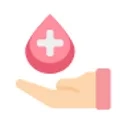Myths vs truths - cord blood banking
Do you want to know if the stem cells from your baby's umbilical cord blood can be used after a few years or if collecting your baby's cord blood during the COVID-19 pandemic is safe?
We hope this post helps to dispel some of the common myths about cord blood banking and explains the facts.
Myth 1: Cord blood has not been used in the treatment of diseases.

FALSE! More than 60,000 cord blood transplants have occurred worldwide. Cord blood, in fact, contains blood-forming stem cells that have been used as a standard form of treatment for over 80 diseases, including blood disorders, solid tumours, immune and metabolic disorders.1 There are also many ongoing clinical trials that keep finding new ways that cord blood stem cells could be used.2
Myth 2: Cord blood can only help my baby.

INCORRECT! Your baby's cord blood could be used to protect his or her siblings.
Myth 3: Cord blood cannot be used after a few years.

WRONG! Your baby's cord blood can be stored indefinitely at cryogenic temperatures below -135°C and still be viable.3
Myth 4: Having my baby's cord blood, cord lining, and cord tissue collected during the COVID-19 pandemic is risky.

NOPE! Evidence shows that the risk of direct transmission during delivery is low, and the COVID-19 virus strain, which can be passed on to the blood and tissue in the umbilical cord, was not found in samples from the mother or the baby.4 In the majority of COVID-19 human-to-human transmissions, the virus is spread primarily through direct contact with an infected person's respiratory droplets and by touching surfaces or objects contaminated with the respiratory droplets.5
Myth 5: I can decide whether to save my baby's umbilical cord blood stem cells while in labour or after he or she is born.

INACCURATE! The decision to store your baby's umbilical cord blood stem cells should be made and planned ahead of time as you have only one chance to collect your baby's cord blood, which is at birth. Parents-to-be can talk to their obstetrician about storing their baby's cord blood as early as the second trimester (Week 13 to Week 28).
Myth 6: It don't need to store my baby's cord lining if I'm storing my baby's cord blood.

UNTRUE! The umbilical cord lining contains two other types of lifesaving stem cells, such as mesenchymal stem cells (MSCs) and cord lining epithelial stem cells (CLECs), which can only be harvested and expanded using patented CellOptimaTM technology. Keeping both the cord blood and the lining of the cord allows you to get the most out of all types of stem cells. This gives your family more options for treating health problems in the future.
References:
- For the full list of treatable diseases and references, please refer to https://www.cordlife.com/sg/treatable-diseases.
- Diseases and Disorders that have been in Clinical Trials with Cord Blood or Cord Tissue Cells page. Parent's Guide to Cord Blood Foundation website. https://www.parentsguidecordblood.org/en/diseases#trial. Accessed June 9, 2021.
- Cells For Life website. https://cellsforlife.com/how-long-can-cord-blood-stem-cells-be-stored. Accessed June 15, 2021.
- Schwartz DA. An Analysis of 38 Pregnant Women With COVID-19, Their Newborn Infants, and Maternal-Fetal Transmission of SARS-CoV- 2: Maternal Coronavirus Infections and Pregnancy Outcomes. Arch Pathol Lab Med. 2020;144 (7):799-805
- Royal College of Obstetricians and Gynaecologists: Coronavirus (COVID-19) Infection in Pregnancy-Information for healthcare professionals. Ver 11; 2020: 1-68.
Recent Blog Posts
- 28 Mar 2025
- 10 Nov 2023
- 19 Oct 2022
- 19 Oct 2022
- 19 Oct 2022
